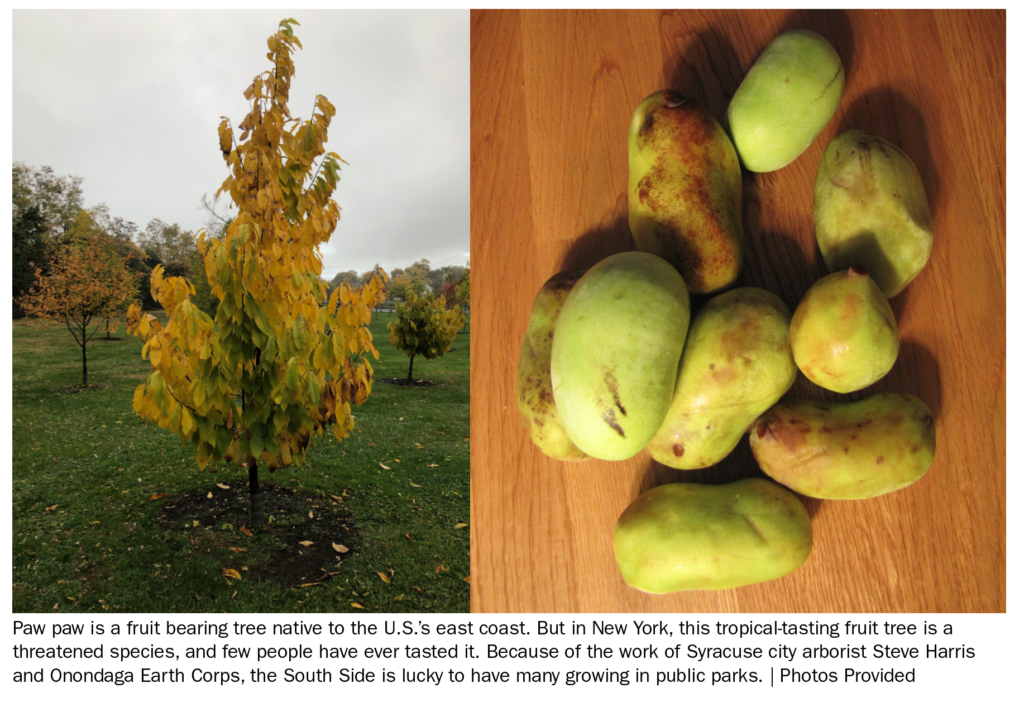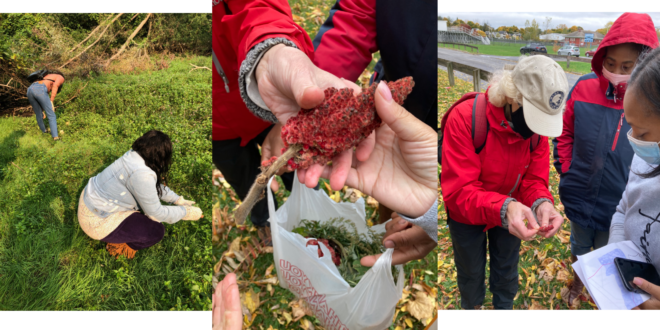Contributed by Marie Claire Bryant, Antonisha Owens and Anne C. Bellows
Did you know there is healthy food growing all around the South Side of Syracuse and probably in your backyard?
We are studying use and accessibility of wild-growing edible and medicinal plants in Kirk Park, Corcoran High School fields, Wadsworth Park, Elmwood Park, Springdale and others. This research is in cooperation with South Side business and neighborhood representatives and a university-community research group based at Syracuse University and SUNY-College of Environmental Science and Forestry. These South Side parks include “urban food forests,” meaning they contain nutritious plants like oak trees (which produce acorn nuts), paw paw trees, blackberry and raspberry bushes, herbaceous plants like water mint, roses (producing rose hips), wild basil, wild grape, cattail and much more.

One use of our urban food forests’ bounty can be seen at Antonisha Owens’ local business. Walking into her salon and beauty shop, Aficapure Artisan and Hair Clinique, is a sensual experience. Visitors are soothed by herbal scents, flowers falling from the ceiling, the chirps of real parakeets and a waterfall and vibrant décor. Having learned from her grandmother and through independent research, she makes beauty products like soaps, scrubs and hair oils from natural ingredients, some of which she picks from forests in the area. Her creations, in ornamental jars or wrapped in tissue paper, line the walls.
I, Marie Claire Bryant, who moved to Syracuse this summer to join SU’s Food Studies program, met Owens in September when we began working on the Syracuse Urban Food Forest Project. Together we’ve sampled a wide variety of wild edibles in and around the local parks: black raspberries in July and wild grapes, rose hips, burdock and water mint throughout the summer and fall. My research explores the potentials of urban food forests in Syracuse and elsewhere.
Having grown up in Syracuse, Owens recognizes that the South Side has issues with health, poverty and hunger, but healthy food and economic stability have always been in our backyard. We have walnut trees and sugar maple trees and dandelion greens growing there! Why should we depend on corner stores for all of our needs when we have pockets of edibles nearby?

Having been connected to the project by Cimone Jordan, a planner with the Syracuse Neighborhood and Business Development Department, Owens joined foraging walks and realized that many of the expensive ingredients she buys for her singular beauty products such as mint, paw paw seeds and rose hips, can be picked from trees, bushes and ground plants near her home. Owens hopes others will see potential in food forests for business and community development, among other community health issues.
The goal of our research is to encourage South Side residents and businesses to harvest and help maintain the food forests. Anyone can harvest from these public parks, but harvesting requires some adeptness at identifying delicious and nutritious plants. We invite interested community members, especially local restauranteurs and caterers, to join in future foraging walks in 2021, where they can learn and share about edible plants. The more residents who harvest from the local food forest as a source of nourishment, the more the forest could thrive. Responsible harvesting (picking conservatively, always leaving enough for others and for plant rejuvenation) of roots, leaves and fruits from plants can stimulate their growth and be healthy for the environment.
Finally, urban food forests can be an indicator of social justice. While the South Side has a number of established and newer parks, it also has a great deal of paved landscape and sparse residential and street-lined greenery relative to many other parts of the city. Canopy, the shady roof of tree-lined streets and parks, is usually a measure of neighborhood wealth as well as health. Foliage cleans the air and provides relief from summer heat made worse by climate change; the average summer heat index on the South Side is higher than surrounding neighborhoods. Tree roots stabilize soils and trap storm water run-off that can otherwise flood streets, creeks, canals and lakes.
Contributor bios:
Marie Claire Bryant is an avid forager and a graduate student in the Food Studies department at Syracuse University with a particular focus on urban food systems. She is originally from Nashville, Tenn.
Antonisha Owens is a licensed cosmetologist and beauty product artisan. She forages within the city of Syracuse for ingredients for the beauty care products she shells in her retail salon located on the South Side of Syracuse. She loves building community with other entrepreneurs and helping them build their businesses with a sustainable, “earth-core” approach so they can revitalize their neighborhood.
Anne C. Bellows loves to cook, eat, feed, forage, grow and share food. She teaches in the Food Studies Program at Syracuse University, participates with the new Syracuse-Onondaga Food Systems Alliance (SOFSA) and is a board member of FIAN International.
 The Stand
The Stand


